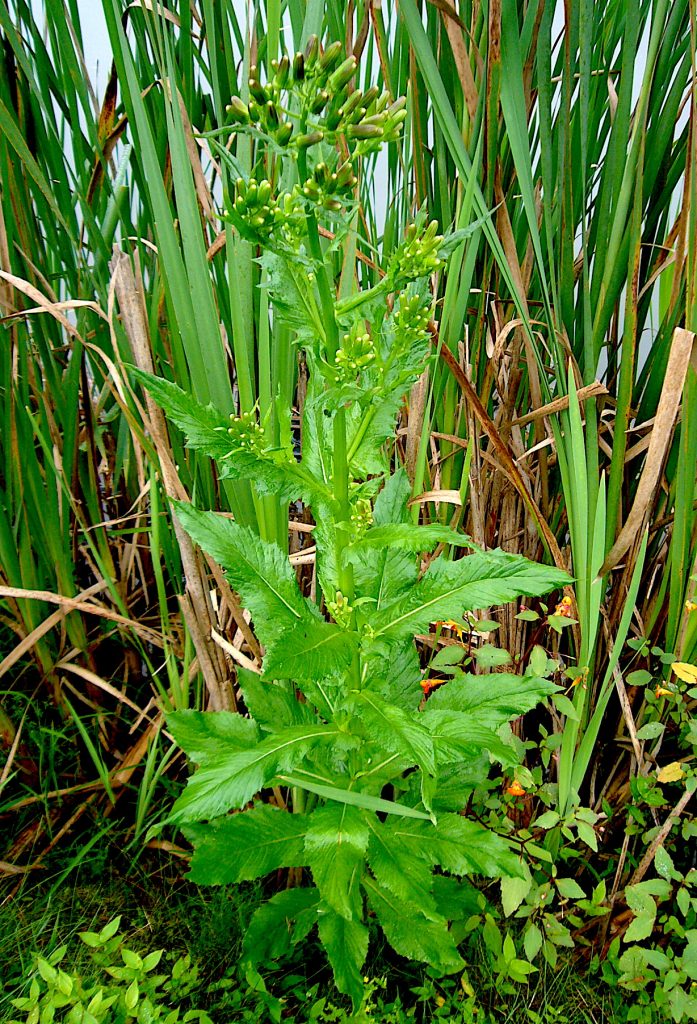
Burnweed/Fireweed in blossom in front of cattails in North Carolina. Photo by Green Deane
Fireweed/Burnweed has a flavor chefs love. With an impossible scientific name and strong aroma Fireweed is often over looked by the foraging community. Conversely the aroma is also a good identifying characteristic. As with several things in life tastes vary and many people enjoy the Fireweed raw or cooked. Closely related to the Dandelion, the Fireweed locally favors the late winter or early spring. Currently you can find Fireweed from a few inches high to a couple of feet. While they do not grow in colonies often several will grow near each other. Soon the older ones will put on yellow blossoms that barely open, another identifying characteristic. Of course in greens young and tender is usually preferable and this is particularly true with the Fireweed which grows rank as it ages. To read about fireweed go here.
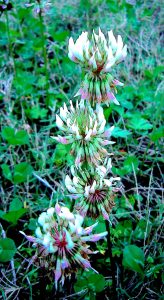
Clover prefers low nitrogen soil.
Clover is one of those wild edibles that is both overstated and understated. The overstatement is from writers who offer it as a great human food full of this and that to keep us healthy. The understated part is that it can harbor a fungus that inhibits clotting and somewhere around a half-a-cup of raw leaves can make you throw up. Individual experience, of course, can vary and there are several different species of clover with different characteristics. Pictured here is a nice little White Clover which is blossoming now mostly in lawns and athletic fields. A few leaves can be eaten raw. They are high in protein for a leaf. The blossom fresh or quickly dried can be used for tea. There is also Crimson, Red, Sweet and even Tick Clover.
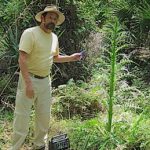
Foraging classes are held rain, shine, hot or cold. Photo by Nermina Krenata
Foraging classes: Avoid the viral crowds and be outside in great weather this weekend. I have a foraging class in Jacksonville Saturday and Ft. Desoto near St. Petersburg Sunday.
Saturday, March 14th, Florida State College, south campus, 11901 Beach Blvd., Jacksonville, 32246. We meet at Building “A” next to the administration parking lot. 9 a.m. to noon.
Sunday, March 15th, Ft. Desoto Park, 3500 Pinellas Bayway S. St. Petersburg Fl 33715. There is an entrance fee to the park as well. Meet at the bay fishing pier parking lot. It’s a large parking lot, meet near the bathrooms. We will walk a good bit. 9 a.m. to noon.
Saturday, March 21th, Ft. Meade Outdoor Recreation Area, 1639 Frostproof Highway, Fort Meade, FL 33841. (Frostproof Highway is also Route 98.) 9 a.m to noon. Meet at the second set of bathrooms (in the middle of the park) which is due south from the highway. (Don’t confuse this location with Mead Gardens below which is in Winter Park near Orlando.)
Sunday, March 22nd, Wickham Park, 2500 Parkway Drive, Melbourne, FL 32935-2335. Meet at the “dog park” inside the park. 9 a.m. to noon.
Saturday, March 28th, Haulover Canal, Merritt Island National Refuge, north of the Kennedy Space Center. . Read the instructions below. We meet the the northwest end of the canal area.
Sunday, March 29th, Spruce Creek Park, 6250 Ridgewood Ave. Port Orange FL, meet at the pavilion. 9 a.m. to noon.
Saturday, April 4th, Bayshore Live Oak Park, Port Charlotte, FL, 9 a.m. to noon. Meet at the parking lot at the intersection of Bayshore Road and Ganyard Street.
Sunday, April 5th, Mead Gardens, 1500 S. Denning Dr., Winter Park, FL 32789. 9 a.m. to noon. Meet to the right (east) of the Bartram sign. (Don’t confuse this location with Ft. Mead [above] which is 80 miles further south.)
For more information. to sign up for a class or to pre-pay go here.
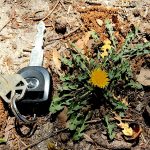
Dandelions do not like Florida.
On the foraging wane now are Stinging Nettles (Urtica genus) and Chickweed (Stelaria genus.) Both are winter edibles along with Dandelions — which are always sparse locally — and Pellitory (Cucumber Weed.) The latter is definitely peaking. Warm weather in March should drop its production off significantly. By April one usually can find it only in deep shade. Also heading out of season is Goosegrass. Still in seasons are sow thistles and various mustards.
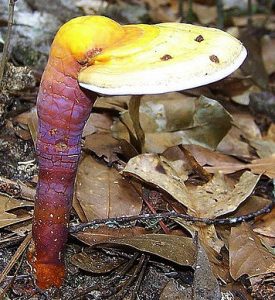
Ganoderma curtisii, a local reishi msuhroom. Photo by Green Deane
When will we be seeing and reading about mushrooms again? The answer is probably after spring rains in April or so. One can find various edible and medicinal mushrooms all year here but April to November is prime time for ground-based fungi (November to April for wood-based fungi.) I harvested several pounds of chanterelles last year. The topic of mushroom came up in the foraging class this week as we saw some “Train Wreckers” and Ganodermas starting their seasonal growth. Several species are called “Train Wreckers” because they can destroy railroad ties. None of them are toxic but some are too tough to digest and are related to Shiitake mushrooms. We also have several species of Ganodermas locally (Reishi) which is a bit of contention. The debate is how many species are there, what are they called, and are they as good as the ones that are sold for medicinal use? As for the latter my herbalist friends say yes, they are as good as the commercial kinds. As for how many and what they are called that probably won’t be settled for decades. I see three, or five, regularly, it’s hard to tell. With certainty I see G. curtisii, G. sessile, and G. zonatum. G. curtisii grows like a short golf club and is the closest relative to G. lingzhi, which is the well-known Chinese Reishi. G. sessile has no stem and grows horizontally (a smaller form is G. sessiliforme.) G. zonatum, more yellow than the rest, is found exclusively on palms and will kill the palm. If your palm has G. zontaum on it there is no hope for it. There is also a Ganoderma that grows on citrus G. tuberculosum. To my knowledge none of the Reishis are toxic — but stick to identified species — and local herbalists report good results with them. These mushrooms stimulate the immune system by providing various molecular “keys’ that unlock and turn on immune cells in the gut. By the way I moderated these pages on Facebook: Southeast U.S. Mushroom Identification, Florida Mushroom Identification Forum, Edible Mushrooms: Florida, Edible Wild Mushrooms and Orlando Mushroom Group (OMG, which also will start to have meetings and fungal forays as soon as the season turns. Last year late rains threw the season off.) Florida Mushroom Identification Forum has some 7,000 members.
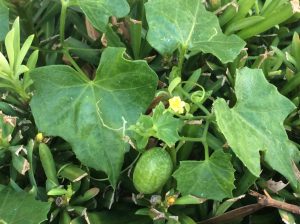
Creeping Cucumber. Photo by Green Deane
Had a foraging classes in Southeast Florida this past weekend at LeStrange Preserve, Ft. Pierce. The foraging find of the day was Creeping Cucumber (In an effort to coin a better common name for that plant some are calling it Mouse Cucumbers.) The Creeping Cucumber … Mouse Cucumber … demonstrates foraging in a 400-mile long state. You can find it fruit somewhere in the state all year. Mentioned many times in recent newsletters the Creeping Cucumber makes a nice trail-side nibble and salad ingredient. Like their larger cousins they don’t pickle well unless you cut off the blossom end. To read more about the jelly-bean size cuke click here.
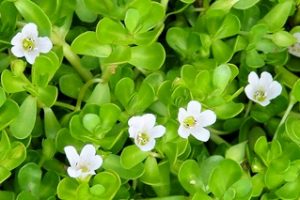
Bacopa monnieri can have four or five petals. Photo by Green Deane
Before I forget it’s time to write about Bacopa again. Actually there are six Bacopas locally, two common: Water Hyssop and Lemon Bacopa. They are quite different and perhaps it takes a trained botanical eye to appreciate their similarities which strike me as few. Perhaps their greatest difference is texture. Lemon Bacopa is soft, fuzzy, and crushes easily. It smells like limes not lemons. Water Hyssop is tough and shiny, resilient. Lemon Bacopa is aromatic and fruity in flavor, Water Hyssop is just pain bitter. Water Hyssop definitely can help with memory issues, Lemon Bacopa is more iffy on that score. One does not find Lemon Bacopa too often whereas Water Hyssop is nearly everywhere the soil is wet and sunny. (There are actually five Bacopas that look like the bitter one we want but four of them are rare. The one we want, Bacopa monnieri, by far the most common, has a single crease on the back of the leaf.) I have found Lemon Bacopa only three times; two of them in the wet ruts of woods roads. There is also a lake near me that has a little growing near a boat ramp when the water level is just right. As my article speaks more towards Lemon Bacopa I will adress Water Hyssop here. It basically stimulates the brain to make new neuronal connections, specifically in the hippocampus. It is anti-inflammatory and interacts with the dopamine and serotenergic systems. As you might expect growing new memory cells enough to notice takes time. So Bacopa has to be taken daily for at least three months. I have had several people tell me it has made significant difference in their lives. It does not work on all causes of memory problems but if it does work it does so dramatically. You can read about both Bacopas here.
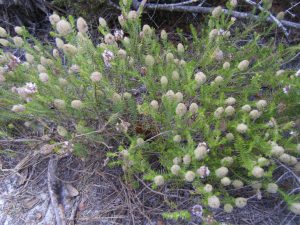
Florida Pennyroyal. Photo by Green Deane
If you are one to wander around any sandy scrub in Florida this time of year you will see the low blooms of the Florida Pennyroyal. It’s quite an unusual plant in that it is monotypic, meaning the only plant in its genus. It’s found along the Central Florida Ridge though I have seen it also on the east coast of the state. There are a few plants in the Bahamas and maybe one or two in southern Georgia. It has the unmistakable aroma of pennyroyal. A species that looks vaguely similar, Florida Rosemary, has no noticeable strong aroma. Florida Pennyroyal used to be the third most common nectar plant in the state but fell off for some unknown reason and was replaced by Bidens alba, aka Spanish Needles. Florida Pennyroyal was used extensively by the natives and has culinary uses. To read more about it go here.
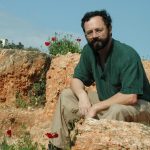
The Nine DVD set includes 135 videos.
Though your foraging may drop off during the winter it’s a great time to study wild edibles with my nine DVD set. Each DVDs has 15 videos for 135 in all. They make a great gift. Order today. Some of these videos are of better quality than my free ones on the Internet. They are the same videos but many people like to have their own copy. I burn and compile the sets myself so if you have any issues I handle them personally. There are no middle foragers. And I’m working on adding a tenth DVD. To learn more about the DVDs or to order them click here.

Green Deane Forum
Want to identify a plant? Perhaps you’re looking for a foraging reference? You might have a UFO, an Unidentified Flowering Object, you want identified. On the Green Deane Forum we — including Green Deane and others from around the world — chat about foraging all year. And it’s not just about warm-weather plants or just North American flora. Many nations share common weeds so there’s a lot to talk. There’s also more than weeds. The reference section has information for foraging around the world. There are also articles on food preservation, forgotten skills from making bows to fermenting food. Several hard-to-find books are there page for page. Recent posts this week include Spring 2020 Plantings, Light Purple Flowers and Fuzzy Leaves, Red Blossoms Hanging Down, Edible Privacy Fence, Tendrilizing, Calculating COVID-19 Mortality Rate, Nettle Spanakopita, Pawpaws Starting Early? What are those White Blossoms, Brazilian Pepper Revisited, Palmer Amaranth, In The Loop, Tomatoes: A Fruit First, a Vegetable Second, and Butterweed: Annual Warning. You can join the Forum by going to the upper right hand top of this page.
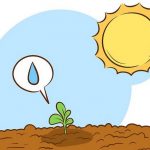 Donations to upgrade EatTheWeeds.com have gone well. Thank you to all who have contributed to either via the Go Fund Me link, the PayPal donation link or by writing to Green Deane POB 941793 Maitland FL, 32794. There are many needs left such as expanding the foraging teacher page and the page on monotypic edibles. There’s always something and such things get more complex and expensive every year.
Donations to upgrade EatTheWeeds.com have gone well. Thank you to all who have contributed to either via the Go Fund Me link, the PayPal donation link or by writing to Green Deane POB 941793 Maitland FL, 32794. There are many needs left such as expanding the foraging teacher page and the page on monotypic edibles. There’s always something and such things get more complex and expensive every year.
This is weekly newsletter 396, If you want to subscribe to this free newsletter you can find the sign-up form in the menu at the top of the page.
To donate to the Green Deane Newsletter click here.

